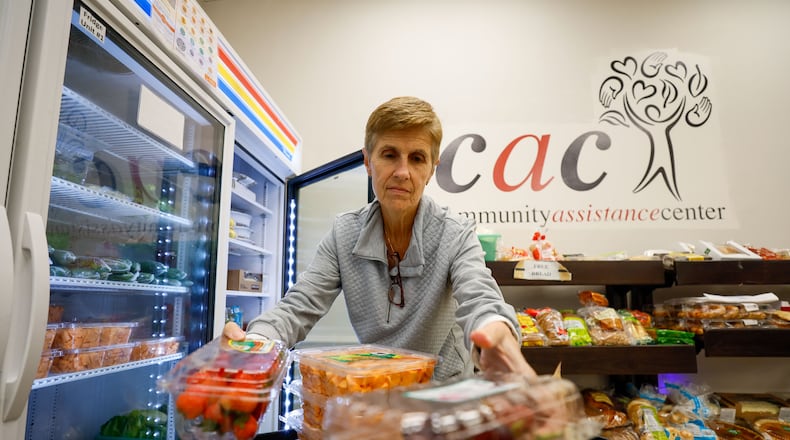Leading up to the nation’s biggest eating day of the year, a 31-year-old woman with a fragile smile said she was grateful and hopeful.
She had just put bags of free food in the trunk of her Hyundai Elantra. Which was a particular joy because she said her savings are about gone and the pantry and refrigerator in her one-bedroom Marietta apartment were almost empty.
All that had remained at home were three eggs, two pieces of bread, a little leftover bean soup and two cans: one of mixed vegetables, the other of sliced potatoes. Also a little peanut butter.
“I try to space out my food as much as I can,” Khristy Laguerre said late one recent afternoon outside the Atlanta Community Food Bank’s Community Food Center in Marietta.
Her last meal had been nearly 24 hours earlier, and her stomach has been making noises, she added. Since moving from New York to Atlanta in March, she said she has struggled to land a job, though the unemployment rate in Georgia is low and she previously worked as a technician for eye doctors.
Food insecurity in the United States rose significantly last year, hitting 17 million households, according to recently released federal data. That exceeded levels seen during the worst of the pandemic, but it didn’t reach the peaks seen in the aftermath of the Great Recession.
In 2022, 12.8% of U.S. households were food insecure at least at some point, compared to 10.2% a year earlier. Food insecurity is defined by the government as when someone’s “access to adequate food for active, healthy living is limited by lack of money and other resources.”
Georgia saw food insecurity rise to 11.3% for the period 2020 through 2022, compared to 10.0% for the period from 2017 through 2019.
Credit: Miguel Martinez
Credit: Miguel Martinez
Food providers cite the end of pandemic-era boosts of federal food aid and the expiration of an expanded child tax credit. They particularly point out that inflation for food began to soar in late 2021 and deep into 2022. Food price hikes slowed significantly in 2023, but costs remain elevated, according to federal data.
The squeeze on family budgets has been difficult, said Kyle Waide, the chief executive officer of the Atlanta Community Food Bank, which supplies food to about 700 pantry operations and other organizations in 29 Georgia counties.
The number of people accessing food from its network jumped 40% in 18 months, he said. “Right now it is as high as it has ever been.”
Through just the first 10 months of the year, a food pantry that serves Sandy Springs and Dunwoody had already distributed more food than it did all of last year or any year earlier in the pandemic, said Laura Deupree, spokeswoman for the Community Assistance Center.
“It has been a radical shift in the last year,” Deupree said.
Most of those picking up free food from the Atlanta Community Food Bank’s network have paying jobs, Waide said. “Inflation was kind of the straw that broke the camel’s back.”
Among those seeking help recently at two free food outlets were a Marietta public school teacher trying to regain her financial footing after a divorce, cafeteria workers, personal caregivers, health care technicians and a babysitter. Virtually everyone brought up the difficulties of grappling with higher prices for groceries and other needs.
Seantel Pate of Palmetto said she drove more than an hour to get to the Community Food Center in Marietta. She makes $14.75 an hour as a “green coat” directing travelers at Hartsfield-Jackson International Airport. Of her five kids, two have special needs. Four days a week, the single mother attends classes to become a medical assistant.
Pate sought out food pantries after she said the government incorrectly cut off her family’s benefits under the Supplemental Nutrition Assistance Program (SNAP), commonly referred to as food stamps. Georgia has struggled to process and pay out on tens of thousands of SNAP applications, including renewals, The Atlanta Journal-Constitution reported earlier this year. The state said it had seen an increase in demand but had fewer workers to process the applications.
“We have nothing,” Pate said. At the Marietta food center she picked up what she could: orange juice, a bag of potatoes, bread, carrots, butter, rolls, eggs and cereal. She said it had been about 18 hours since she last ate.
Credit: Miguel Martinez
Credit: Miguel Martinez
One good development: In recent years many of the networks of pantries and others offering free food have dramatically bolstered their infrastructure to handle the growing load.
Three years ago, the Atlanta Community Food Bank quadrupled its capacity compared to its old buildings, added seven times more freezer and cooler space, and multiplied its number of truck bays from six to about 40. It’s not only distributing more food, it’s also diversifying its offerings, supplying significantly more fresh foods, Waide said.
Not all the work is being done by nonprofits. Many businesses are donating to the efforts.
Atlanta-based for-profit Goodr has helped some companies reduce food waste and increase donations. Among Goodr’s offerings are several mini-grocery stores set up in schools, mostly in metro Atlanta, offering free food to students and their families. A new outlet is expected to open in a city of Atlanta recreation center, possibly early next year.
One of the reasons Jasmine Crowe-Houston launched Goodr stemmed from her earlier efforts to feed families, including distributing turkeys and other foods to help people prepare for Thanksgiving.
“I realized that I had 250 families there and that people are not just hungry in November. I wanted to create something with real, sustainable solutions that people could count on,” Crowe-Houston said.
More than a third of the 650 students at Young Middle School in southwest Atlanta have registered to have their families take part in the Goodr free grocery, which launched a few months ago.
Shanterria Hambrick, a MARTA bus driver, said the Goodr grocery and stops at church pantries help bridge financial gaps she and her husband, a photographer, face in trying to feed four kids and pay other bills.
The Goodr grocery, supported by the Atlanta Gas Light Foundation, is in space once used for a classroom.
“This room has a lot of heart in it,” Ronald Garlington, the school’s principal, said. “It’s beyond just the Cheerios boxes .... There is an emotional aspect: Somebody cares about you.”
About the Author
Keep Reading
The Latest
Featured





